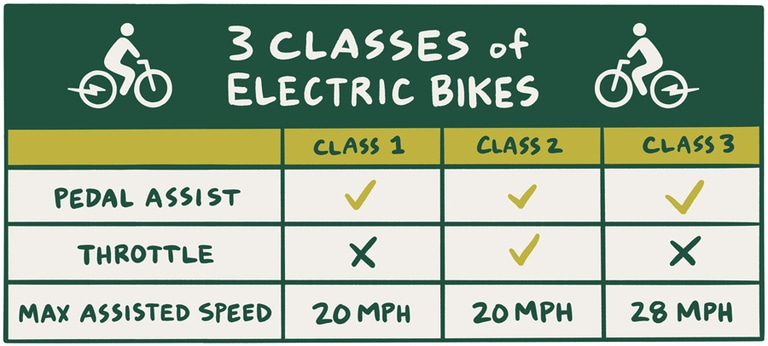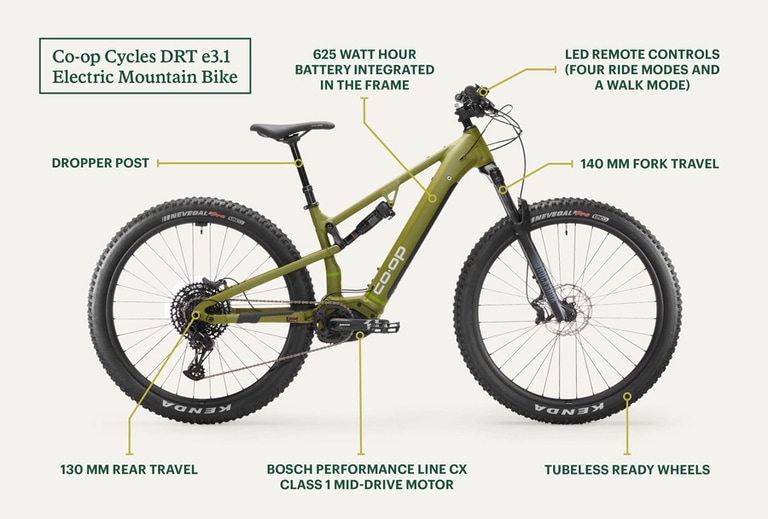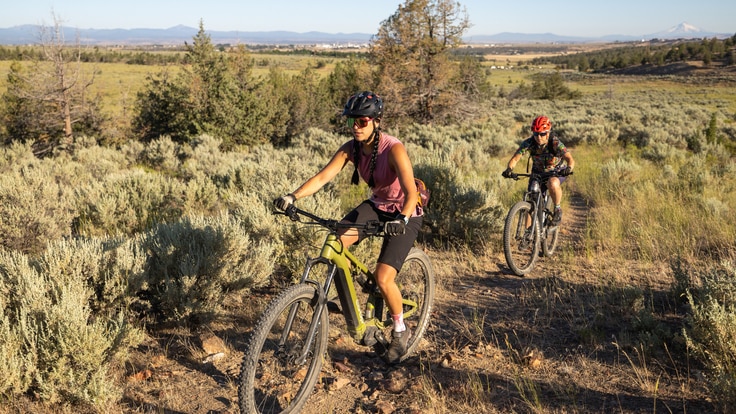Interested in purchasing an electric mountain bike, but not quite sure where to begin? In this article, we'll address some of the most common questions about what electric mountain bikes are, how they operate, their cost, the range you can expect on a single charge and more. By the end of this guide, you'll be well-equipped with general knowledge to decide with confidence and ride away happy. For a more detailed discussion, be sure to check in with bike pros at your local REI store or other bike shop.
What is an electric mountain bike (e-MTB)?
At its core, an electric mountain bike, or e-MTB for short, is a mountain bike equipped with a rechargeable battery that powers a small electric motor. When you pedal, this motor and battery unit provide additional assistance, making it significantly easier to climb steep hills and take longer rides. Electric mountain bikes share many similarities with non-electric mountain bikes, including the same components such as wheels, tires, drivetrain, brakes, suspension and more. From a distance, it's often hard to distinguish between electric and non-electric mountain bikes.
How electric mountain bikes work
Most electric mountain bikes feature a small mid-drive motor mounted near the bottom bracket of the bike (where the crank arms attach to the bike frame). The motor sends power directly to the chainring. Most e-MTB batteries are integrated within the downtube of the bike's frame, while some are mounted externally. When you pedal, this motor provides additional assistance to help propel you forward. Most quality e-MTBs offer various levels of riding modes, from eco-saving to maximum boost, and can be easily adjusted on the fly using a handlebar-mounted remote control.
Who are electric mountain bikes best for?
Everyone! Electric mountain bikes are not simply for beginners or experts. They're a versatile option suitable for riders of all skill levels. For novice riders, e-MTBs provide the opportunity to explore more trails, extend their riding distances and keep up with more experienced friends. For experts, these bikes add an exciting dimension to technical climbs and allow for more time to enjoy the exhilarating descents. After all, isn't that the best part of mountain biking? Additionally, e-MTBs are an excellent choice for riders who have busy schedules, as they offer a convenient way to squeeze in a ride between responsibilities.
Are e-MTBs easy to ride?
Yes! If you can ride a mountain bike (sometimes referred to as an analog bike) then you can ride an electric mountain bike. If you're initially intimidated by the idea of a bike with a motor and extra power, we recommend starting with the lowest level of assistance. As you gain confidence and experience, you can move to a bike with a greater level of assistance. Get more tips in our article, How to Ride an Electric Mountain Bike.
The pros of electric mountain bikes
- Electric mountain bikes make steep and challenging climbs more enjoyable by providing motorized assistance.
- They are ideal for time-strapped individuals, allowing riders to cover more miles in less time.
- Electric mountain bikes create an inclusive experience, effectively bridging the fitness gap between beginners and experts.
The cons of electric mountain bikes
While electric mountain bikes offer many advantages, they're not without some drawbacks, including:
- An e-MTB is notably heavier than a non-electric mountain bike, often weighing an additional 10 to 20 pounds more.
- They tend to be more expensive, typically costing $2,000 more than a comparable model without a motor.
- Due to their increased weight, loading an e-MTB onto a vehicle can be more challenging, and the bikes often require a bike rack that's designed specifically to handle the load. Learn more in this article, How to Choose a Car Rack for E-Bikes.
Riding an Electric Mountain Bike
How far can I ride on a single charge?
It depends. Variables such as the level of assistance you use, the steepness of the terrain, the weight of a rider—even the temperature outside—all play a significant role in battery life, and thus the range. That said, most high-quality e-MTBs from reputable brands can achieve a range of 15 to 25 miles, with 3,000 to 5,000 feet of elevation gain, on a single charge. Get more tips in our article, How Do I Charge an Electric Bike?
How fast do electric mountain bikes go?
Like any other bike, an electric bike can go as fast as you can pedal it, with or without the help of the motor. But the level of assistance you get from them varies depending on the class of bike.

Most e-bike manufacturers and U.S. state, local and other entities have adopted a three-class system for e-bikes. The level of assistance and the speed varies depending on the class. Class 1 electric mountain bikes are the most common. These bikes provide assistance only when you're pedaling. The assist stops when you reach 20 mph. Keep in mind that this speed limit is only for the motorized assist. In other words, the bike doesn't restrict your speed when you're pedaling without assistance or you're going downhill. In those cases, the bike acts like a traditional bike, and you potentially can go much faster (given the right terrain, and assuming you've got the talent to keep the rubber side down).
How long does it take to charge an electric mountain bike?
Charging time varies based on several factors, including battery size. As a general guideline, though, expect a drained e-MTB battery to take anywhere from six to 10 hours to fully recharge. Nobody likes unwelcome surprises, so fully charge your battery the day before you plan to ride. Get more tips in our article, How Do I Charge an Electric Bike?
Where can I ride an electric mountain bike?
Rules and laws surrounding e-MTB trail access are constantly evolving, and different land managers have different regulations. Always check the land manager's current rules before hitting the trail. Know the class of e-bike you're riding and whether that specific class is allowed. Remember, many trails that allow traditional mountain bikes may not allow electric mountain bikes, so check first. Review resources such as PeopleForBikes, TrailsAreCommonGround.org, Ride Spot, Trailforks and MTB Project.
Tips for Hitting the Trail
Finally, it's always smart and thoughtful to be a good ambassador for your sport. That advice is no truer than when riding an e-MTB on the trails, since the technology is new and still finding its place. "Just because you can go 20 mph doesn't always mean you should," says Andy Aiken, Co-op Cycles designer.
For a more in-depth guide, read our article on Mountain Biking Etiquette.
- Always ride a trail in its intended direction. It can be dangerous—to you and to others —to climb a trail that's intended only for descent.
- Instead of riding up the climbing trail, consider taking the road (if there is one). You may not realize how fast you're going, but mountain bikers on traditional bikes notice as you ride up behind them.
- Use common sense. No one enjoys being buzzed by other riders, whether that rider straddles an e-bike or not. Slow down. Be patient and courteous. And say hello as you pass.
Buying an Electric Mountain Bike
Just like any bike purchase, a smart buying process starts by determining your correct frame size based on your height. Next, consider the type of trails you prefer to ride. Match the electric mountain bike to your needs, considering the style and the desired amount of suspension travel. Smoother and flatter trails may require suspension with less travel, typically around 130 to 150 millimeters. Riders tackling steep and rugged terrain, meanwhile, may opt for travel in the range of 150 to 180 millimeters. Learn more from our in-depth guide: How to Choose Mountain Bikes.

Once you've identified the style and type of e-MTB that suits you, turn your attention to key components. The additional weight of e-MTBs and the speeds they can generate mean that good-quality brake systems and suspension are vital. Look for powerful 4-piston hydraulic disc brakes and quality suspension components from name brands that offer plenty of adjustment for various riders. Finally, don't forget to test-ride different e-MTB models, and compare how they feel, to find the perfect fit for your preferences and riding style.
How much should I spend on an electric mountain bike?
Electric mountain bikes come with a significant price tag due to their expensive motors and batteries. We recommend budgeting around $4,500 and up for a quality full-suspension e-MTB. Doing so will provide you with a bike that has quality drive systems from manufacturers such as Bosch, Shimano or Fazua. That price point also will ensure that you get a dependable drivetrain, brake system and suspension components from well-known brands such as SRAM, Fox, Shimano, TRP or others. The e-MTB market offers a wide range of e-MTB options at many prices, and it's easy to find models that exceed $10,000, especially for carbon fiber frames with top-tier components. You don't need to spend nearly that amount to get in the game, though.
Maintenance and Care for e-MTBs
Whether motorized or not, all types of mountain bikes require proper maintenance and care—like cleaning and lubing chains—to perform at their best. However, with their powerful motors and additional weight, electric mountain bikes place extra strain on the drivetrain and brake components. High-wear areas of e-MTBs include chains, cassettes, chainrings and brake pads. We recommend that you regularly inspect these components throughout the riding season to ensure they are in good condition, that they are functioning optimally, and that you repair and replace them as needed. Consult your owner's manual for suggested service levels. Some e-bikes have recommended maintenance cycles programmed into the bike's computer. For more tips on how to care for your e-bike and how often to get it serviced, read Intro to Electric Bike Maintenance.
Can I wash my e-MTB? Yes! Keeping the bike clean will help extend its life. It's best to avoid using a pressure washer on the electronics, or spraying water directly on the motor and battery areas of an e-MTB. While these parts have been designed to handle puddles and wet-weather rides alike, you want to avoid forcing water into the system. Learn more in our article. How to Clean a Bike.
While each manufacturer has its own instructions about caring for and storing the bike's battery, the general rule is the same: During long stretches of inactivity, store your battery (with about a 70 percent charge) in a cool, dry place that has a temperature between 50° to 70°F.

